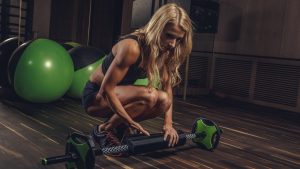
Understanding Posture and Its Importance
Before delving into the efficacy of daily squats, let’s comprehend the significance of posture. Posture refers to the alignment and positioning of your body parts, specifically the spine, when sitting, standing, or moving. Poor posture can lead to muscle imbalances, discomfort, and long-term spinal issues.
The Role of Squats in Posture Improvement
Squats, a compound movement targeting multiple muscle groups, have garnered attention not only for building lower body strength but also for their potential to enhance posture. Here’s how squats contribute to better posture:
Strengthening Core Muscles
A fundamental aspect of maintaining good posture is a strong core. Squats engage the abdominal muscles, obliques, and lower back, thereby improving core strength. A strong core helps support the spine and maintain its natural curvature, aiding in better posture.
Engaging Postural Muscles
Performing squats correctly engages various postural muscles, including the erector spinae, glutes, and quadriceps. These muscles play a crucial role in stabilizing the spine and pelvis, assisting in maintaining an upright posture.
Counteracting Sedentary Lifestyles
In today’s sedentary lifestyle, prolonged sitting can lead to weakened muscles and poor posture. Squats act as a countermeasure by actively engaging muscles that might otherwise remain inactive throughout the day.
The Frequency Debate: Should You Squat Every Day?
While squats offer numerous benefits for posture improvement, the question of whether they should be performed daily remains contentious. Here are some considerations:
Muscular Recovery and Overtraining
Muscles require time to repair and recover after a workout. Performing squats every day without adequate rest can lead to overtraining, potentially causing muscle fatigue and increased injury risk.
Variation and Rest Days
Instead of doing squats daily, incorporating variations and allowing rest days between squat sessions is advisable. Including different types of squats, such as goblet squats, sumo squats, or Bulgarian split squats, can target muscles from various angles while providing adequate recovery time.
Consistency and Moderation
Consistency is key for seeing improvements in posture. Rather than daily squats, a well-structured routine that includes squats multiple times per week alongside other posture-enhancing exercises can yield better results without risking overtraining.
A Balanced Approach is all you need
While squats can significantly contribute to better posture in females, performing them daily might not be the most optimal approach. Instead, a balanced routine incorporating various squat variations, alongside other posture-enhancing exercises, and allowing sufficient rest between workouts can yield better results in the long run.
Improving posture is a holistic process that involves mindful sitting, standing, exercising, and stretching. Alongside squats, incorporating exercises targeting upper back, shoulder, and neck muscles can complement efforts to achieve an ideal posture.
Remember, it’s crucial to listen to your body and consult with a fitness professional or healthcare provider to tailor an exercise routine that aligns with your fitness goals and overall health.
So.
Improving posture involves a holistic approach that extends beyond exercises. Consistency, variety, and moderation in workouts, coupled with mindful daily habits, contribute significantly to achieving and maintaining good posture. Squats can undoubtedly be a valuable addition to your routine, but balance is key to reaping their benefits without risking overexertion.
The Impact of Squats on Female Posture: A Holistic Approach
In the pursuit of better posture, it’s crucial to adopt a holistic approach that goes beyond just performing squats. Here, we’ll explore additional elements that complement squat exercises and contribute to improved posture in females.

1. Strengthening the Upper Body
While squats primarily target the lower body, neglecting the upper body can lead to imbalances. Incorporating exercises that strengthen the upper back, shoulders, and neck can support the spine and enhance overall posture. Some beneficial exercises include:
Rows: Various rowing exercises, such as bent-over rows or seated rows, engage the upper back muscles, promoting better posture by countering rounded shoulders.
Shoulder Retraction Exercises: These exercises, like band pull-aparts or scapular retractions, focus on pulling the shoulders back, combating the forward head posture often associated with modern lifestyles.
2. Flexibility and Mobility Work
Adequate flexibility and mobility are crucial for maintaining proper posture. Tight muscles can pull the body out of alignment, affecting posture negatively. Incorporating stretching and mobility exercises can help:
Hip Flexor Stretches: Prolonged sitting can lead to tight hip flexors, affecting posture. Stretches targeting these muscles, such as lunges or kneeling hip flexor stretches, can alleviate tightness.
Thoracic Mobility Exercises: Improving mobility in the upper back (thoracic spine) can counteract the forward-leaning posture often observed from excessive sitting or poor exercise habits.
3. Postural Awareness in Daily Activities
Beyond structured exercises, being mindful of posture during daily activities significantly impacts overall posture improvement. Simple adjustments like:
Ergonomic Workstations: Setting up workstations ergonomically by adjusting chair height, monitor position, and using supportive cushions can prevent slouching and promote better posture during long hours of work.
Mindful Movement: Practicing mindful movement and body awareness during daily activities, such as standing tall while waiting in line or sitting with the back straight, reinforces good posture habits.
4. Balanced Lifestyle Factors
In addition to exercise, lifestyle factors play a pivotal role in posture:
Healthy Nutrition: Adequate nutrition supports muscle health and overall body function, contributing to better posture by providing the body with essential nutrients for muscle repair and growth.
Adequate Rest and Recovery: Quality sleep and adequate rest periods between workouts are crucial for muscle recovery, allowing the body to repair and adapt to exercises like squats effectively.
Conclusion: A Comprehensive Approach to Posture Improvement
Incorporating squats into a well-rounded routine is undeniably beneficial for posture enhancement in females. However, achieving and maintaining good posture involves a multifaceted approach encompassing various exercises, mindful habits, and lifestyle adjustments.
Remember, there’s no one-size-fits-all approach to improving posture. Tailor your routine to your specific needs and consult with fitness professionals or healthcare providers for personalized guidance. By combining squats with upper body strengthening, flexibility work, postural awareness, and a balanced lifestyle, females can achieve significant improvements in their posture, leading to enhanced well-being and confidence.
External Resources for Holistic Posture Improvement:
Physical Therapy Web – Upper Body Strengthening Exercises
Spine-health – Stretching for Back Pain Relief
Harvard Health Publishing – How to improve posture with daily habits
American Council on Exercise – Correcting Poor Posture
Mayo Clinic – Core Exercises: Why You Should Strengthen Your Core Muscles
Harvard Health Publishing – The importance of good posture
A comprehensive approach to posture improvement involves various elements beyond exercise. Strengthening the upper body, enhancing flexibility, maintaining postural awareness, and considering lifestyle factors significantly contribute to achieving and maintaining optimal posture. Squats, when combined with these elements, form part of a holistic strategy for better posture in females.
Comparison tabular
| Aspect | Squats | Upper Body Strengthening | Flexibility and Mobility | Postural Awareness | Lifestyle Factors |
|---|---|---|---|---|---|
| Primary Focus | Lower body strength | Upper back, shoulders, and neck muscles | Muscle flexibility and joint mobility | Conscious alignment during daily activities | Nutritional support, rest, and recovery |
| Contribution to Posture | Engages core muscles, stabilizes spine and pelvis | Supports spine, counters rounded shoulders | Alleviates muscle tightness, prevents postural imbalances | Reinforces good posture habits throughout the day | Provides essential nutrients, aids muscle repair and growth |
| Frequency | Moderate, not necessarily daily | Varied exercises targeting different muscle groups | Regular stretching routines | Consistent practice in daily activities | Consistent healthy habits, including sleep and hydration |
| Additional Benefits | Improved lower body strength and functionality | Enhances upper body strength and stability | Increases joint range of motion, reduces stiffness | Heightened body awareness, reduces strain on muscles | Supports overall health, boosts energy levels |
| Potential Risks | Overtraining if done excessively without proper rest | Injury risk if exercises are performed with incorrect form | Strain or injury if stretches are pushed too far | None, but incorrect posture may persist unknowingly | Nutritional deficiencies, inadequate rest affecting muscles |
This table provides a comparative overview of how squats, upper body strengthening, flexibility and mobility work, postural awareness, and lifestyle factors contribute to posture improvement while highlighting their unique aspects, benefits, and potential risks.
Remember, the key to reaping the benefits of these elements lies in balance, consistency, and mindful practice. A holistic approach encompassing these various aspects can significantly enhance posture and overall well-being.
Wrapping up
Improving posture is a journey that involves embracing a holistic approach. While exercises like squats play a pivotal role in strengthening specific muscle groups and stabilizing the body, they are just one piece of the puzzle.
By incorporating various elements such as upper body strengthening, flexibility and mobility work, mindfulness in daily activities, and considering lifestyle factors like nutrition and rest, individuals can foster a more comprehensive and effective path toward better posture.
Remember, it’s not about doing one exercise every day but rather about creating a balanced routine that encompasses different exercises, mindful habits, and lifestyle adjustments. Embrace this holistic approach to posture improvement, listen to your body, and seek guidance from professionals to tailor a plan that suits your unique needs. With dedication and consistency, achieving and maintaining better posture becomes an achievable and rewarding journey towards overall well-being and confidence.

Hey there, it’s Mike Rrsq, the Editor-in-Chief over at Jsquat.com, and I’m absolutely obsessed with all things squat fitness! I’ve been lucky enough to get some serious recognition for my work in this field. With a solid background in the fitness and wellness industry, I’ve been there right from the get-go, helping shape this website into what it is today.
You see, I’m not just the boss around here; I’m also a passionate contributor. I love sharing my insights through my articles, and trust me, they’re not your run-of-the-mill stuff. Each piece I write is a labor of love, filled with my expertise and real-world experience in the fitness universe. So, if you’re into fitness and looking for some inspiration, you’re in the right place!
Related Posts
- Is incorporating isometric squats beneficial for improving running performance
Isometric squats, a form of exercise where you hold a position rather than moving through…
- Should seniors over 50 do squats to improve posture
Squats can be incredibly beneficial for seniors over 50, aiding in various aspects of health…
- Improving Posture: Is the Back Squat the Right Choice
Posture plays a pivotal role in overall health and well-being. Many seek exercises to strengthen…
- Can squats be done daily?
Hey there, fitness enthusiasts and curious minds! 🏋️♀️🏋️♂️ Looking to dive into the world of…
- Is incorporating squats with tempo beneficial for bodybuilding purposes
Absolutely, tempo squats can be a game-changer for bodybuilders looking to maximize their gains. The…
- Is incorporating squats beneficial for relieving piriformis syndrome
Piriformis syndrome can be an uncomfortable and limiting condition, causing pain and discomfort in the…
- Doesn't squatting improve overall posture?
Hey there, posture-conscious readers! Ever wondered how a simple exercise like squatting can have a…
- Is incorporating sumo squats effective for improving hip mobility
When it comes to enhancing hip mobility, fitness enthusiasts and athletes often delve into a…
